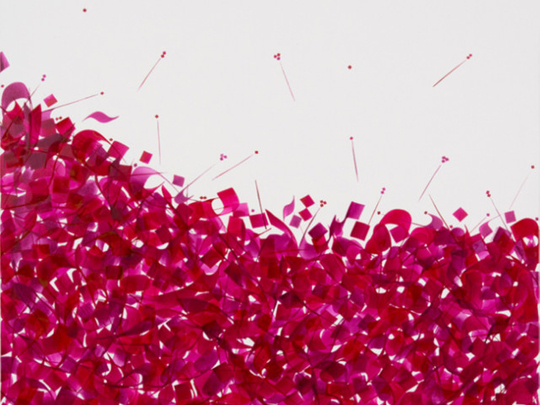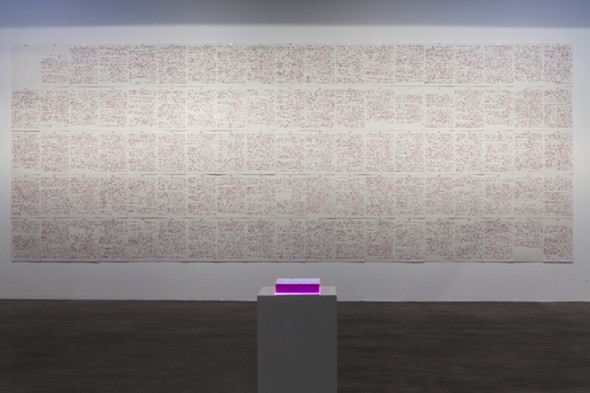
Pouran Jinchi is interested in investigating the relationship between words and forms. The New York-based artist, who was born in Iran, takes inspiration from Iranian literature and Islamic calligraphy to create visual interpretations of poems and texts. Her latest work, “The Blind Owl”, is inspired by a book of the same name by Iranian writer Sadegh Hedayat and continues her exploration of the complexities of the written word using a variety of different media and her own contemporary version of Islamic calligraphy.
Hedayat’s book, published in the 1930s, explores a grim fascination with death and was banned in Iran because of its dark narrative. But for Jinchi, it represents a link with her past. “At that time, I was a teenager, growing up in Iran, and was curious about the book mainly because it was banned. The government and our parents were concerned about the effect its theme of death and destruction would have on impressionable minds, but the book had little impact on me. A few years ago I came across an English translation of the book and read it again, and I realised that it is an incredible literary work. The book brought back so many memories of my teenage years in Iran. And I also saw a similarity between my text-based art and the visual symbolism, layering and repetition in Sadegh’s writing. The idea behind this series is to convey in a visual form the nostalgia the book evoked in me, the darkness and sense of danger associated with it, and the depth and beauty of Sadegh’s writing,” Jinchi says.
As the starting point of her exploration of the book, Jinchi chose a quote from it that says: “I write only for my shadow which is cast on the wall in front of the light. I must introduce myself to it.” She then played with the 71 letters in the original Farsi quote, deconstructing it and reassembling it in different ways, and using different media to create a variety of visual translations of the text.
One of these is a jigsaw-puzzle-like arrangement of 71 pieces of paper, each bearing a letter from the quote drawn in ink. The letters are decorated with beautiful patterns, derived from traditional Iranian art, and a pair of tiny copper triangles that symbolise the ears of the owl mentioned in the book’s title. Jinchi has experimented with enamel paint on clay-board panels to create another set of “text paintings”. The series also includes two ink-on-canvas paintings, where the layers of jumbled letters refer to the layered narrative of the book, while also conveying the artist’s own experience of memories flooding in.
But perhaps the most tangible expression of the words is seen in Jinchi’s sculptures, where the letters are cut from thin copper plates and linked together with copper wire. Tiny red rectangles, representing the dots in the Farsi script, dangle from some of the letters. The twisted letters and their sharp metallic edges evoke the element of danger associated with the book, and recall the artist’s fear and excitement when she first read “The Blind Owl”. But the shiny cluster of letters also reflects the depth, beauty and power of Hedayat’s words.
Other works in the series are based on the entire book. An installation titled, “Dots”, consists of 95 pages filled with dots. Each numbered page corresponds to a page of the book and is decorated with the copper “owl’s ears” symbol. And every dot on each page corresponds exactly to the dots on the pages in the book. It took the artist many hours to transpose the dots from the Farsi letters in the original work on to blank white sheets to create this version of the book where the words are missing, yet present in their absence.
An equally intense labour of love is a representation of the book in Plexiglas. Here, Jinchi has hand-written the entire book with markers on sheets of Plexiglas, which have been placed on top of each other to create a book-like installation. The layered words form an abstract pattern when viewed from above. The artist chose this process for creating this piece because her research indicated that fearing a ban on his book, Hedayat had written 50 copies of the book by hand to distribute among his friends.
“My aim was to give this book a whole new life. I wanted to present a visual experience of the quote and the book in many different ways and with different materials because they are interpreted differently by every reader. Just as the book draws readers into the dark head of its protagonist, I hope viewers will be drawn into my artworks. I picked this quote as the focal point of the series because it expresses the author’s feeling that his voice is not being heard and that the only one who can hear his voice is his own shadow. As an artist I could relate to his need to be heard. And translating his words into a visual language is a way of making that happen,” Jinchi says.
Jyoti Kalsi is an arts enthusiast based in Dubai.
“The Blind Owl” will run at The Third Line gallery until October 24.



